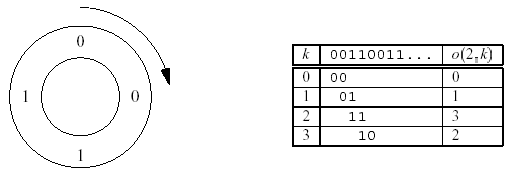Ouroboros Snake
| Time Limit: 1000MS | Memory Limit: 65536K | |
Description
Ouroboros is a mythical snake from ancient Egypt. It has its tail in its mouth and continously devours itself.
The Ouroboros numbers are binary numbers of 2^n bits that have the property of "generating" the whole set of numbers from 0 to 2^n - 1. The generation works as follows: given an Ouroboros number, we place its 2^n bits wrapped in a circle. Then, we can take 2^n groups of n bits starting each time with the next bit in the circle. Such circles are called Ouroboros circles for the number n. We will work only with the smallest
Ouroboros number for each n.
Example: for n = 2, there are only four Ouroboros numbers. These are 0011;0110;1100; and 1001. In this case, the smallest one is 0011. Here is the Ouroboros circle for 0011:

The table describes the function o(n;k) which calculates the k-th number in the Ouroboros circle of the smallest Ouroboros number of size n. This function is what your program should compute.
The Ouroboros numbers are binary numbers of 2^n bits that have the property of "generating" the whole set of numbers from 0 to 2^n - 1. The generation works as follows: given an Ouroboros number, we place its 2^n bits wrapped in a circle. Then, we can take 2^n groups of n bits starting each time with the next bit in the circle. Such circles are called Ouroboros circles for the number n. We will work only with the smallest
Ouroboros number for each n.
Example: for n = 2, there are only four Ouroboros numbers. These are 0011;0110;1100; and 1001. In this case, the smallest one is 0011. Here is the Ouroboros circle for 0011:

The table describes the function o(n;k) which calculates the k-th number in the Ouroboros circle of the smallest Ouroboros number of size n. This function is what your program should compute.
Input
The input consists of several test cases. For each test case, there will be a line containing two integers n and k (1<=n<=15; 0<=k<2^n). The end of the input file is indicated by a line containing two zeros. Don抰 process that line.
Output
For each test case, output o(n;k) on a line by itself.
Sample Input
2 0 2 1 2 2 2 3 0 0
Sample Output
0 1 3 2
————————————————————受伤的分割线————————————————————
前言:什么Fleury算法。。。无视!dfs解决一切。
思路:其实和POJ-1780 Code那道题思想一致。只不过这次是二进制数而已。而且不要求输出路径,要求输出路径上第k个数。边权搞定。依然是按照显式栈DFS解决,独立完成1A,小激动。
代码如下:
/*
ID: j.sure.1
PROG:
LANG: C++
*/
/****************************************/
#include <cstdio>
#include <cstdlib>
#include <cstring>
#include <algorithm>
#include <cmath>
#include <stack>
#include <queue>
#include <vector>
#include <map>
#include <string>
#include <climits>
#include <iostream>
#define INF 0x3f3f3f3f
using namespace std;
/****************************************/
const int M = 40000, N = 20000;
int n, k;
int tot, head[N], path[M];
struct Node {
int v, w, next;
}edge[M];
int sta[M][2], pi;
void add(int u, int v, int w)
{
edge[tot].v = v;
edge[tot].w = w;
edge[tot].next = head[u];
head[u] = tot++;
}
void Euler()
{
int top = -1;
sta[0][0] = 0; sta[0][1] = -1;
top++;
while(top != -1) {
int u = sta[top][0], w = sta[top][1], i;
for(i = head[u]; i != -1; i = edge[i].next) {
if(edge[i].v != -1) {
int v = edge[i].v;
edge[i].v = -1;
top++;
sta[top][0] = v;
sta[top][1] = edge[i].w;
break;
}
}
if(i == -1) {
if(w != -1) path[pi++] = w;
top--;
}
}
}
int main()
{
#ifdef J_Sure
// freopen("000.in", "r", stdin);
// freopen(".out", "w", stdout);
#endif
while(scanf("%d%d", &n, &k), n||k) {
tot = 0;
memset(head, -1, sizeof(head));
int m = 1<<n, base = 1<<(n-1);
for(int i = m-1; i >= 0; i--) {
int u = i >> 1, v = (~base) & i;
add(u, v, i);
}
pi = 0;
Euler();
printf("%d\n", path[pi-k-1]);
}
return 0;
}
























 670
670











 被折叠的 条评论
为什么被折叠?
被折叠的 条评论
为什么被折叠?








